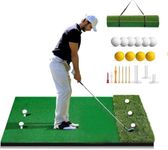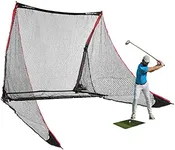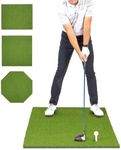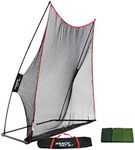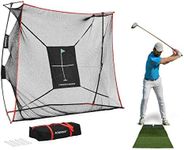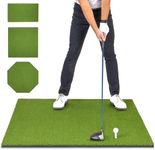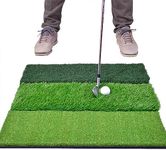Buying Guide for the Best Golf Hitting Mats
Choosing the right golf hitting mat can make a big difference in your practice sessions, whether you're working on your swing at home, in the garage, or outdoors. The right mat will help protect your clubs, provide a realistic feel, and last through many practice sessions. To find the best fit, it's important to understand the key features that affect performance, comfort, and durability. By considering your practice habits, available space, and personal preferences, you can select a mat that enhances your training and helps you improve your game.Mat SizeMat size refers to the overall dimensions of the hitting surface. This is important because it determines how much space you have to stand, swing, and place your golf ball. Smaller mats are more portable and fit well in tight spaces, but they may limit your movement and stance options. Medium-sized mats offer a balance between space and portability, making them suitable for most home setups. Large mats provide ample room for full swings and can accommodate both right- and left-handed golfers, but they require more space to set up. To pick the right size, consider where you plan to use the mat and how much room you need to swing comfortably.
Surface MaterialThe surface material is what you hit the ball from, and it affects how realistic the mat feels compared to real grass. Some mats use basic synthetic turf, which is durable but may feel hard and unforgiving on your wrists and clubs. Others use advanced fibers that better mimic the feel and response of natural fairway grass, providing a more authentic experience. If you want a mat that feels closer to real golf conditions and is easier on your joints, look for one with high-quality, dense fibers. If durability and cost are your main concerns, a basic synthetic surface may be sufficient.
Tee CompatibilityTee compatibility refers to whether the mat allows you to use real golf tees or only fixed rubber tees. Some mats have holes or slots for inserting real tees, which lets you adjust tee height just like on a real course. Others only work with built-in rubber tees, which can be less flexible. If you practice a lot of drives or want to simulate on-course conditions, a mat that accepts real tees is a good choice. If you mostly practice irons or don't mind a fixed tee height, this feature may be less important.
Thickness and CushioningThickness and cushioning describe how much padding is under the hitting surface. Thicker mats with more cushioning help absorb the impact of your club, protecting your wrists, elbows, and clubs from injury or damage. Thin mats may feel hard and can lead to discomfort or even injury over time, especially if you practice frequently. For regular or intense practice, choose a mat with good thickness and shock absorption. If you only practice occasionally or need a lightweight mat, a thinner option might be enough.
DurabilityDurability is about how well the mat holds up to repeated use. Mats made with high-quality materials and strong backing will last longer and maintain their feel over time, even with frequent practice. Cheaper mats may wear out quickly, develop holes, or lose their realistic feel. If you plan to use the mat often or want it to last for years, look for one with a reputation for durability and reinforced construction. If your use will be light or occasional, durability may be less of a concern.
PortabilityPortability refers to how easy it is to move, store, or transport the mat. Lightweight and foldable mats are easy to carry and store, making them ideal if you need to set up and take down your practice area frequently or move the mat between locations. Heavier, more solid mats may offer better stability and feel, but are harder to move. Consider how often you'll need to move the mat and choose a level of portability that matches your needs.


